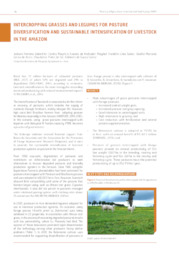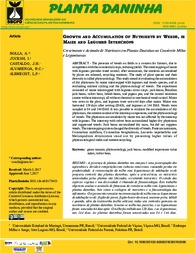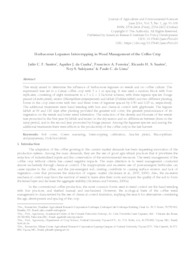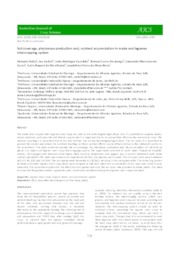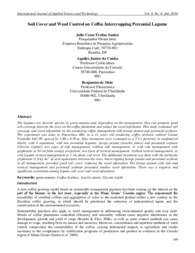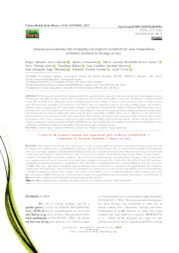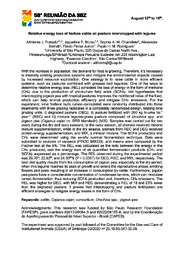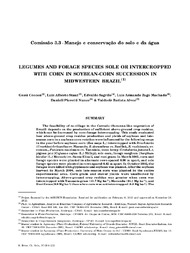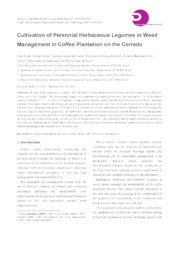Search Publications
Filter by:
| Author(s): VALENTIM, J. F.; ANDRADE, C. M. S. de; SALES, M. F. L.; ASSIS, G. M. L. de; SA, C. P. de; COSTA, F. de S. Brazil has 112 million hectares of cultivated pastures (IBGE, 2017), of which 52% are degraded and 25% in degradation (DIAS-FILHO, 2014), according to estimates. Livestock intensification is the main... ... |
| Author(s): NOLLA, A.; JUCKSH, I.; CASTALDO, J. H.; ALVARENGA, R. C.; ALBRECHT, L. P. The presence of weeds on fields is a concern for farmers, due to competition with the commercial crops, reducing yields. The intercropping of maize with legumes provides weed control; after senescence... ... |
| Author(s): GUT, G. A. P.; EMERENCIANO NETO, J. V.; SANTO, R. da S.; MELO, R. F. de; NOGUEIRA, D. M.; DIFANTE, G. dos S.; GURGEL, A. L. C.; SANTANA, I. L. O. The stud article aimed to assess the accumulation and rates of nutrients in the biomass of the consortium of millet and leguminous plants for green fertilisation. The treatments were consortia of mill... ... |
| Author(s): SANTOS, J. C. F.; CUNHA, A. J. da; FERREIRA, F. A.; SAKIYAMA, N. S.; LIMA, P. C. de
|
| Author(s): NOLLA, A.; JUCKSH, I.; CASTALDO, J. H.; ALVARENGA, R. C.; COSTA, L. M. da; DAMY, C. R. da S.; MOTA NETO, L. V. da The maize intercropped with legume cover crops are used at low technological agriculture, due it?s potential to suppress weeds, recycle nutrients, and cover the soil. Weeds suppression it is important... ... |
| Author(s): SANTOS, J. C. F.; CUNHA, A. J. da; MELO, B. de The legumes are favorite species in green manure and, depending on the management, they can promote good soil coverage between the rows on the coffee plantation and reduce the weed infestation. This s... ... |
| Author(s): GALEANO, E. S. J.; FERNANDES, T.; ORRICO JUNIOR, M. A. P.; ALVES, J. P.; RETORE, M.; ORRICO, A. C. A.; MACHADO, L. A. Z.; Eduardo Festozo Vicente; CECCON, G. This research evaluated the biomass productivity and nutritional value of the haylage and hay from intercropping between Tamani grass and different legume species. For the productive characteristics o... ... |
| Author(s): FURTADO, A. J.; BRUNO, J. F.; CHAMILETE, S. A. M.; BERNDT, A.; PERNA JUNIOR, F.; RODRIGUES, P. H. With the increase in population, the demand for food is growing. Therefore, it’s necessary to intensify existing production systems and mitigate the environmental impacts caused by increased resource... ... |
| Author(s): CECCON, G.; STAUT, L. A.; SAGRILO, E.; MACHADO, L. A. Z.; NUNES, D. P.; ALVES, V. B. The feasibility of no-tillage in the Cerrado (Savanna-like vegetation of Brazil) depends on the production of sufficient above-ground crop residue, which can be increased by corn-forage intercropping.... ... |
| Author(s): SANTOS, J. C. F.; CUNHA, A. J. da; FERREIRA, F. A.; SANTOS, R. H. S.; SAKIYAMA, N. S.; LIMA, P. C. de The aim of this study was to evaluate the cultivation of perennial herbaceous legumes on weed control and yield of the coffee crop in the Cerrado. The experimental design was a randomized complete blo... ... |
Observation
Some of Embrapa's publications are published as ePub files. To read them, use or download one of the following free software options to your computer or mobile device. Android: Google Play Books; IOS: iBooks; Windows and Linux: Calibre.
Access other publications
Access the Agricultural Research Database (BDPA) to consult Embrapa's full library collection and records.
Visit Embrapa Bookstore to purchase books and other publications sold by Embrapa.

